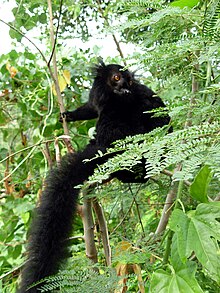Big makis
| Big makis | ||||||||||||
|---|---|---|---|---|---|---|---|---|---|---|---|---|

Red- fronted lemur ( Eulemur rufifrons ) |
||||||||||||
| Systematics | ||||||||||||
|
||||||||||||
| Scientific name | ||||||||||||
| Eulemur | ||||||||||||
| Simons & Rumpler , 1989 |


The great Makis ( Eulemur ) are a primate genus from the group of lemurs (Lemuriformes). As things stand today, the genus comprises twelve species.
features
Large Makis reach a body length of 30 to 45 centimeters, in addition there is a 45 to 65 centimeter long tail. The weight varies from 1 to 3 kilograms. Most species show a distinct gender dichromatism : males and females are colored differently. The fur is usually brownish or gray in color and lighter on the belly, the muzzle is elongated, the head is often dark. Sometimes there is bushy hair on the cheeks or chin. With the exception of those of the blue - eyed lemur, the large eyes are orange-yellow.
distribution and habitat
Large Makis are native to the island of Madagascar , where they are found in almost all parts of the country with the exception of the central unforested highlands. They can be found both in the dry forests in the west and in the rain forests in the east of the island. Two species (the Mongozmaki and the Brown Maki ) were also introduced to the Comoros .
Lifestyle and diet
These primates are cathemeral , which means that they often do not have a distinct day-night rhythm. Often the degree of their nocturnal activity depends on the moonlight, sometimes also on the season. They mostly stay in the trees, where they either climb or jump on all fours, with their long tail serving as a balance.
Social behavior is variable, besides species that live in groups of several males and females (such as the Mohrenmaki and the Brown Maki) there are also species that live in monogamous family groups, such as the Mongozmaki and the red-bellied lemur . No ranking can be seen in the groups. They mark their territories with the secretion of their anal glands, but the area covered by them can overlap over a large area with that of other groups.
The food consists mainly of plant material, mostly fruits and leaves, the composition can vary considerably depending on the species, season and habitat. To a lesser extent, they also eat small animals such as insects , spiders and millipedes .
Reproduction
The breeding of the Great Makis is seasonal. After a gestation period of around 125 days, the females give birth to one or two young in the period from August to October (just before the start of the rainy season). These cling to the mother's belly, later they ride on her back. They are weaned after about five months and sexually mature after about one and a half years.
threat
The natural enemies of the Great Makis include the fossa and other Malagasy predators, as well as birds of prey. However, all species suffer much more from the destruction of their habitat through slash and burn , deforestation or mining. In addition, some species are hunted, for example because of their meat. The population numbers of all types go back, the IUCN lists almost all species as "vulnerable" ( vulnerable ) or ( "high risk" endangered ).
Systematics
The big Makis are counted in the family of the common Makis (Lemuridae). The genus was only established in 1989. Before the animals were in the same class as the Katta ( lemur classified). Despite great similarities in the skeleton structure, they are not very closely related to this.
Due to the elevation of some earlier subspecies to the rank of independent species, the number of species has increased significantly in recent years. There are currently 12 known species (according to Mittermeier et al., 2008):
-
fulvus group, E. fulvus and former subspecies
- Brown Maki ( Eulemur fulvus )
- Bald Lemur ( Eulemur albifrons )
- White-collar lemur ( Eulemur cinereiceps , formerly E. albocollaris )
- Collared lemur ( Eulemur collaris )
- Red Maki ( Eulemur rufus )
- Red- fronted lemur ( Eulemur rufifrons )
- Sanford Maki ( Eulemur sanfordi )
- Crowned Lemur ( Eulemur coronatus )
- Blue-eyed lemur ( Eulemur flavifrons )
- Mohrenmaki ( Eulemur macaco )
- Mongozmaki ( Eulemur mongoz )
- Red-bellied lemur ( Eulemur rubriventer )
literature
- Thomas Geissmann : Comparative Primatology. Springer-Verlag, Berlin et al. 2003, ISBN 3-540-43645-6
- Russell A. Mittermeier , Jörg U. Ganzhorn, William R. Konstant, Kenneth Glander, Ian Tattersall , Colin P. Groves , Anthony B. Rylands, Andreas Hapke, Jonah Ratsimbazafy, Mireya I. Mayor, Edward Louis jr, Yves Rumpler, Christoph Schwitzer, Rodin Rasoloarison: Lemur Diversity in Madagascar. In: International Journal of Primatology. 29, 2008, ISSN 0164-0291 , pp. 1607-1656.
- Ronald M. Nowak: Walker's Mammals of the World. 6th edition. Johns Hopkins University Press, Baltimore MD 1999, ISBN 0-8018-5789-9 .

